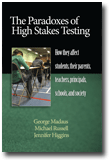
The Paradoxes of High Stakes Testing
How They Affect Students, Their Parents, Teachers, Principals, Schools, and Society
By:
George Madaus, Boston College
Michael Russell, Boston College
Jennifer Higgins
Published 2009
As a nation, we spend more than $1 billion a year on federally mandated educational tests that 30 million students must take each year. The country spends an additional $1.2 billion on test preparation materials designed to help students pass these tests. While test mandates were put in place with good intentions, increasingly educational leaders and policy makers are questioning these test based reform efforts. Some question whether these programs are doing more harm than good. Others call for the development of more and better tests.
Given the vast amount of resources our nation pours into testing, is it time we pay closer attention to these testing programs? Is it time we hold the testing industry and policy makers accountable for the tests they make and use? Is it time we invest resources to develop new ways of testing our students? The Paradoxes of High-Stakes Testing explores these and other questions, as it helps parents, teachers, educational leaders, and policy makers better understand the complexities of educational policies that use tests as a lever for improving the quality of education.
The book explores:
>> how testing is used to enable teachers and schools to be more effective and improve student learning,
>> why testing is so ingrained in the American psyche and why policy makers rely on testing policies to reform our educational system,
>> what we can learn from a long history of test-based reform efforts that have occurred over centuries and across continents,
>> what effects testing has on teaching and learning in our schools when it is used to solve political, social, or economic problems.
Most importantly, the book describes several ways in which testing can be improved to provide more accurate and more useful measures of student learning. Many of these improvements capitalize on technology to provide teachers with more detailed, diagnostic information about student learning and measure skills that some leaders argue are essential for the 21st century work force. Exploring what is within reach is critical because current testing policies are hindering these improvements.
Finally, given that testing is and will continue to be an integral part of our educational system, the book concludes that, like other sectors of our society, educational testing must be more closely monitored to ensure that high quality tests are used to measure student achievement and to minimize the negative effects that testing has on students, schools, and our society. Given the opportunity our nation has to rethink and redesign its testing policies, The Paradoxes of High-Stakes Testing presents a clear strategy to maximize the positive effects of educational testing.
CONTENTS
Acknowledgements 1 The High-Stakes Testing Mania. 2 Why Has Testing Become So Important? 3 What Is a Test? 4 What Human and Cultural Factors Affect Test Performance? 5 What Technical Issues Affect Test Validity? 6 Why Is It Important to Regard Testing As a Technology? 7 Why Is the History of Testing Important? 8 What Are the Paradoxical Consequences of High-Stakes Testing? 9 What Is the Future of Testing? 10 Why and How Should High-Stakes Testing Be Monitored? Bibliography
REVIEWS
"Madaus, Russell, and Higgins (all, Boston College) provide an exemplary overview of the consequences of high-stakes testing in the context of contemporary school reform policy. A major theme in this book centers on the assertion that high-stakes testing is the driving force behind school reform policy today. The authors argue that school reform policies, based solely on high-stakes testing, were mandated before careful research on the potential advantages and disadvantages. As members of the testing community, the authors do find value in testing; however, they also recognize its limitations, especially in the context of diverse populations. Those in charge of developing and implementing school reform policies today would find this to be an excellent resource; however, the book is also appropriate for a wide audience. Summing Up: Highly recommended. All readership levels." J. C. Agnew-Tally Park University in Choice
-
Paperback978-1-60752-027-6
Price: $28.74
-
Hardcover978-1-60752-028-3
Web price: $80.74 (Reg. 94.99)
- eBook9781607529835

- EDU030000 - EDUCATION: Testing & Measurement
- EDU037000 - EDUCATION: Research
- EDU015000 - EDUCATION: Higher
-
 (Re)Envisioning Social Studies Education Research
Current Epistemological and Methodological Expansions, Deconstructions, and Creations
(Re)Envisioning Social Studies Education Research
Current Epistemological and Methodological Expansions, Deconstructions, and Creations
-
 Affirming Identity, Advancing Belonging, and Amplifying Voice in Sororities and Fraternities
Affirming Identity, Advancing Belonging, and Amplifying Voice in Sororities and Fraternities
-
 Expanding the Vision of Faculty Learning Communities in Higher Education
Emerging Opportunities for Faculty to Engage Each Other in Learning, Teaching, and Support
Expanding the Vision of Faculty Learning Communities in Higher Education
Emerging Opportunities for Faculty to Engage Each Other in Learning, Teaching, and Support
-
 Faculty Learning Communities
Working Towards a More Equitable, Just, and Antiracist Future in Higher Education
Faculty Learning Communities
Working Towards a More Equitable, Just, and Antiracist Future in Higher Education
-
 Institutional Diversity in American Postsecondary Education
Institutional Diversity in American Postsecondary Education
-
 Promoting Equitable Classroom Practices in Higher Education
Approaches Beyond Curriculum
Promoting Equitable Classroom Practices in Higher Education
Approaches Beyond Curriculum
-
 The Handbook for Aspiring Higher Education Leaders
The Handbook for Aspiring Higher Education Leaders

